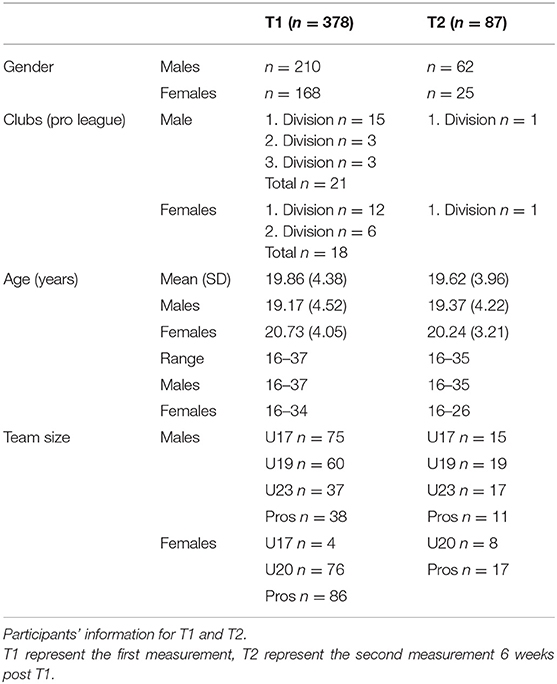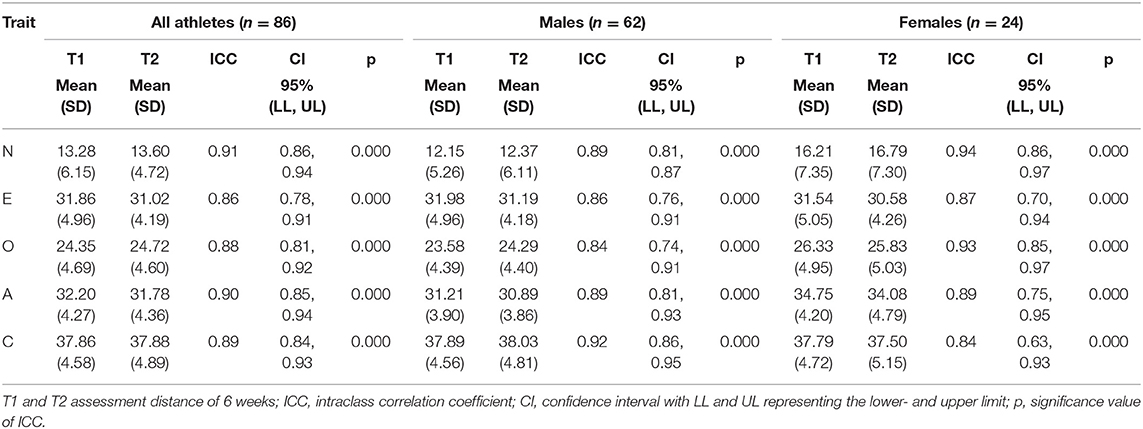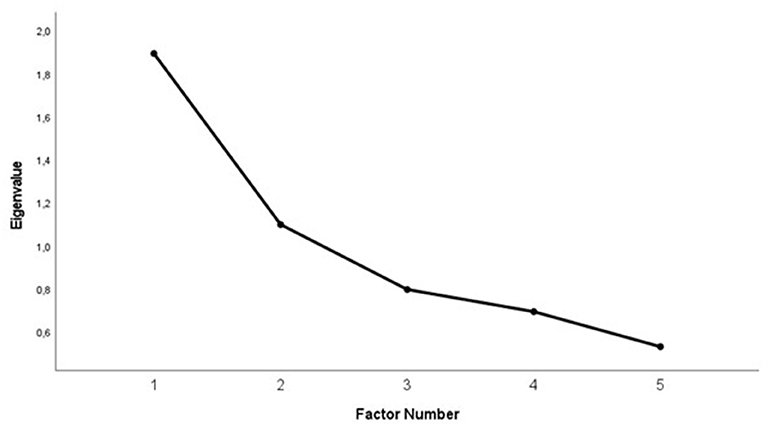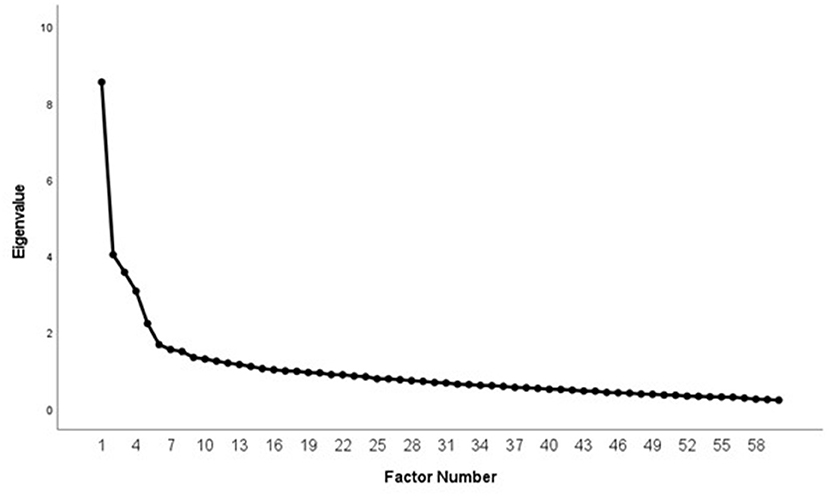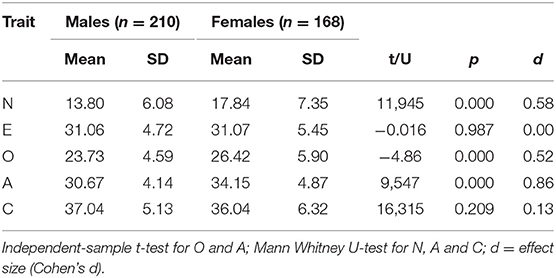Personality in Soccer: Investigation of the Five-Factor Model of Personality in High-Level Athletes
- 1Department of Sports Sciences, Saarland University, Saarbrücken, Germany
- 2TSG ResearchLab, Zuzenhausen, Germany
Background: In high-level sports, rapid screening and diagnostic instruments are necessary considering limited access that researchers have to these athletes. In the area of sport psychological diagnostics, the NEO-FFI is a promising tool to gain information about an athlete's personality traits. The current study investigated the NEO-FFI's scientific quality criteria and general application to elite-level soccer.
Methods: Personality traits of 378 elite-level soccer athletes were assessed using the NEO-FFI. Analysis focused on internal consistency, factor structure and gender differences. Additionally, a second measurement with a 6-week interval was conducted with a sub-sample of 86 athletes to analyse test-retest reliability.
Results: Overall, the results are in line with previous findings outside high-level sports. For the total sample, alpha-levels from 0.68 to 0.84 and intraclass correlation coefficients (ICC) for test-retest measures from 0.86 to 0.91 could be found. Item-level principal component analysis using both oblimin and oblique rotation showed better stability in neuroticism (N) and conscientiousness (C) than in extraversion (E), openness (O), and agreeableness (A). Gender differences could be found in values of internal consistency, ICC and NEO-FFI traits.
Conclusion: The results of this study demonstrate good transferability of the NEO-FFI from settings outside high-level sports into this specific niche of sport psychological assessment. However, the same weaknesses of the applied instrument in general populations were also replicated in the sporting population.
Introduction
In comparison to physiological approaches, psychological assessments in professional sports are rather seldom, particularly in soccer. Yet measuring the psychological aspects of athletes is rapidly gaining popularity and many of the well-established measurements from domains external to sport (i.e., cognitive and differential psychology) are now being applied in sporting domains. Examples of assessments that have already made this transition is the measurement of athletes' executive functions (Beavan et al., 2020), emotional behaviors (Schilaty et al., 2016), and of particular interest for this research, personality (Smith, 2008; Zhang et al., 2019). In the area of differential psychology, the classification of the Five Factor Model of Personality (FFM) is well-established (McCrae and Costa, 2008). The FFM assesses personality of an individual on five traits: Neuroticism (N), Extraversion (E), Openness (O), Agreeableness (A), and Conscientiousness (C); hence being commonly referred to as “the big five.” Despite some criticism of whether there are less (Eysenck and Eysenck, 1985; Gray, 1991; Zuckermann, 2005) or more than five dimensions (Paunonen and Jackson, 2000), the FFM is based on a general consensus in modern research and is widely accepted (O'Connor, 2002; de Moor et al., 2012; Allen et al., 2013; Bircher et al., 2017).
The NEO Personality Inventory (NEO-PI) and its subsequent revised version (NEO-PI-R) were developed as a measure of the FFM of personality (McCrae and Costa, 1985; Costa and McCrae, 1992). The NEO-PI-R contains 240 items that are grouped accordingly to one of the five personality dimensions. Despite the NEO-PI-R measuring narrower personality traits with more scales, the time commitment to complete the questionnaire is a limitation for many time-scarce populations, requiring up to 60 min to complete. In high performance settings where practitioners may be allocated limited time access to players, the use of the shorter version of the NEO-PI-R may be more appropriate (Egan et al., 2000). The NEO Five-Factor Inventory (NEO-FFI) is a shortened version of the NEO-PI-R, consisting of only 60 items that take between 10 and 15 min to complete (McCrae and Costa, 1987). It has demonstrated validity and utility in several different contexts and languages and is one of the most used instruments to assess the FFM (Egan et al., 2000; Zillig et al., 2002).
Reliability measures of the NEO-FFI has first been mentioned by Costa and McCrae (1992) in an English speaking sample, which has shown internal consistencies of 0.89 (N), 0.79 (E), 0.76 (O), 0.74 (A), and 0.84 (C) that were later supported (Holden and Fekken, 1994). Egan et al. (2000) similarly reported ranges between 0.72 (O) and 0.87 (N) on a large and diversified British cohort. Results from Eastern Europe and Iran also confirmed similar findings (Hrebíčková et al., 2002; Anisi, 2012). Of particular importance for the current study, the translation by Borkenau and Ostendorf (1993) found reliability indexes between 0.71 and 0.85 in a German population sample that were later on verified (Schmitz et al., 2001). Furthermore, test-retest reliability separated by a 2-week break has also been positively supported, ranging from 0.89 (N), 0.86 (E), 0.88 (O), 0.86 (A), and 0.90 (C) (Robins et al., 2001). Although the test-retest stability of the NEO-FFI is high, concerns for the factor structure of the NEO-FFI have been highlighted in the literature. Holden and Fekken (1994) conducted a factor analysis on the NEO-FFI using Canadian female students, reporting low loadings of ≥0.30 in 55 of 60 items. Various studies further reported some items not loading highly on their corresponding component when using factor analyses (Rolland et al., 1998; Egan et al., 2000; Aluja et al., 2005).
As a solution to the loading concerns, McCrae and Costa (2004) replaced 14 items of the original NEO-FFI with newer items taken from the NEO-PI-R in order to improve the instruments factor structure. The selection criteria were: (1) minimized effects of acquisition responding, (2) increased NEO-PI-R factor score correlation, and (3) diversification of item content in favor of underrepresented facets of remaining items of the scales. The newest version of the NEO-FFI showed correlations from 0.56 (O) to 0.62 (N) in self report adjective factors, 0.39 (C) to 0.53 (O) in NEO-PI factors in spouse and 0.34 (C) to 0.59 (O) in peer ratings (Costa and McCrae, 2008). Convergent correlation ranges from 0.34 to 0.62. The newest version of the NEO-FFI scales account for about 75–85% variance of the original NEO-PI factors for convergent criteria. However, remaining concerns about the loading were once more highlighted by Aluja et al. (2005) who compared the old and revised NEO-FFI version in a Swiss (n = 1,090) and Spanish (n = 1,006) sample with unsatisfying results, observing that 10 items did not fit into a perfect five-factor structure because of loadings being lower than 0.30.
Although the NEO-FFI has been described as a quick and effective inventory to measure the FFM and may be the preferable choice in time-scarce populations, the data on populations such as high-performance sport is insufficient. Practitioners and researchers alike would benefit from not having to rely on generalizations sourced from normative data outside sporting populations. Despite the wide range of studies using the NEO-FFI, there are less studies published that have specifically focused on physically active subjects (Allen et al., 2013; Wilson and Dishman, 2015; Piepiora, 2020). Moreover, no studies currently exist that target a large sample of athletes in elite-level populations, and specifically in soccer. Therefore, the current study aimed to examine the internal consistency, test-retest reliability, and trait- respective item-level analysis of the factor structure of the NEO-FFI on a sample of German national and international high-level soccer athletes. Additionally, a second aim was to analyse differences between male and female athletes in responding style and traits. It is hypothesized that the NEO-FFI will demonstrate to be reliable and suitable measure of the FFM in high-level athletes, consistent with the literature that has used this inventory in non-sporting populations.
Method
Participants
A total of 378 elite-level soccer athletes (210 male; 168 female) aged 16–37 (M = 19.86 years, SD = 4.38) participated in the study (Table 1). Inclusion criteria were German native speakers to prevent the dataset of biases sourced from aspects like misunderstanding or socialization in other cultural environments, age 16 and older, absence of self-reported suffer from a psychological disorder or any condition that would impair their results and being an athlete in one of the German professional league teams' club academy. In sum, all athletes were representing clubs of the professional soccer leagues within Germany at the time of the study, totalling 21 male and 18 female clubs. All athletes were team members ranging from the U17's to senior professionals. Altogether, 200 athletes (52.91%) have been or were currently part of a youth or adult National team of 15 different countries (mainly Germany, Switzerland, Austria).
Personality Assessment
In order to determine the athletes' personality traits, the German NEO-FFI adaption by Borkenau and Ostendorf (2008) was used. The questionnaire consists of 60 items rated on a five-point Likert scale (strongly disagree, disagree, neutral, agree, strongly agree). It is a self-report measure that assesses the five personality dimensions: extraversion, neuroticism, openness, agreeableness, and conscientiousness. It was presented using an online survey (Microsoft Forms, Version 2020) in original form, order, and instruction.
Procedure
Athletes involved in the study were tested via an online survey. The assessment had a standardized introduction and familiarization protocol, and a staff-member with sport psychological background could always be consulted. Before the participants started, they were informed that all results would remain anonymous, and participation was voluntary. Prior to the commencement of this study, informed consent from all athletes was received, and the Institutional Ethics Committee approved this study.
Testing Session 1 (T1)
The online survey of T1 was either forwarded by the team management of the different clubs or sent directly in terms of personal contact. In the case of one first division club (110 athletes, 71 males/39 females; M = 19.86 years, SD = 4.08), the questionnaire was part of a regular standardized, twice-yearly sports psychological performance diagnostics event recorded during pre-season. This team was chosen because of the test-retest reliability study as described below. Testing took ~10–15 min to read and complete the introduction, demographic information, and personality assessment.
Testing Session 2 (T2)
To assess test-retest reliability of the NEO-FFI, the first division club mentioned above were asked to complete the assessment again 6 weeks after T1. A window of +1 week was allowed for the retest. In total, 86 athletes (62 male, 24 female) aged between 16 and 35 (M = 19.62 years, SD = 3.96) participated at T2. The athletes completed the exact same testing as on T1.
Data Analysis
The dataset was screened and checked for any kind of missing values and the relevant assumptions for parametric tests (i.e. outliers, independence, normality, sphericity, and homogeneity of variance) were measured and met in accordance with Tabachnick and Fidell (2014). Inspections of descriptive and graphical data analysis were executed to prove absence of outliers and normality distribution. Cronbach's alpha determined internal consistency. Test-retest reliability was calculated via an intraclass correlation coefficient (ICC) based on the dataset of 86 athletes using a single measure two-way mixed effect model with an absolute agreement type. Confidence intervals (95% CI) are reported. Gender differences were analyzed using an independent-sample t-tests for parametric and Mann-Whitney-U for non-parametric variables. In addition, Cohens' d effect-size was calculated. Exploratory factor analysis on trait- and item-level were based on principal component analysis with both oblique and orthogonal rotations.
Results
Internal Consistency
Cronbach alpha's internal consistency measures for T1 (Table 2) showed a range from 0.68 (O/A) to 0.84 (N) for all athletes. Interestingly, females showed higher reliability scores than males in all traits, exhibited as 0.71 (A) to 0.87 (N), 0.56 (A) to 0.80 (C), respectively.
Test-Retest Reliability
One outlier could be detected in accordance with Tabachnick and Fidell (2014). To minimize its impact and to keep it as part of the population, a SQRT-transformation of the N-variables was conducted. For the 86 athletes who were retested, ICC test-retest reliability scores from 0.86 (E) to 0.91 (A) was observed (Table 3). In comparison, females (n = 24) had, except for C (ICC = 0.84 vs. 0.92 in males), higher scores ranging from 0.84 (C) to 0.94 (N) than males (n = 62) ranging from 0.84 (O) to 0.92 (C).
Intercorrelations Between NEO-FFI Trait Scores
The NEO-FFI dimensions show various correlations (Table 4). Significant associations could be found for N with lower E and C, respectively, E with higher A and C. O was the only trait where no significant relations could be found. Principal component analysis with quartimax rotation of the orthogonal traits revealed a two-component solution (Figure 1) which converged in three iterations and explained 59.75% of the variance, with eigenvalues being 1.90 and 1.10. Table 5 shows results from component analysis. Component 1 had a high negative loading for N (−0.78) and high positive loadings for E (0.66), A (0.54), and C (0.67). Component 2 was defined by high loading of O (0.86) and lower loadings of E (0.42) and A (0.49).

Table 4. Intercorrelations between NEO-FFI trait scores (n = 378) on the upper right, p-values on the lower left, plus gender separation.
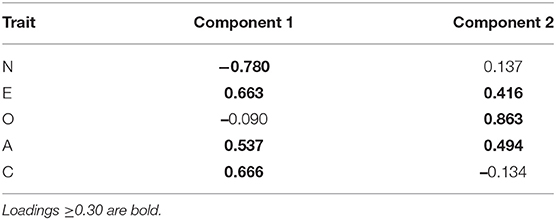
Table 5. Component-analysis of the first two quartimax components extracted from analysis of the NEO-FFI traits (n = 378).
Item-Level-Analysis of the NEO-FFI
For the analysis of sources of variance in the component solution, principal component analysis of the 60 items was conducted: 16 components with eigenvalues from 8.54 to 1.02 could be extracted. A total variance of 59.09% of the variance of the NEO-FFI could be explained. The components converged in 25 iterations in varimax rotation. Scree plot suggested a five-component solution with a 35.68% explanation of total variance as the main source of NEO-FFI (Figure 2).
Varimax Rotation of the NEO-FFI Items-5 Factor Solution
Table 6 displays loadings between the NEO-FFI Items and the first five orthogonal extracted components with varimax rotation. Items were re-ordered and labeled to improve readability.

Table 6. Component-analysis of the first five (orthogonal) varimax factors extracted from analysis of the NEO-FFI (n = 378).
Component 1 is clearly N, with all items except of N1 loading on the component. It also contains five items from the E component (E3, E8, E9, E10, E12), two from A (A2, A10) and one from C (C7). Component 2 represents unequivocally C, with all items loading on the dimension and one item of A (A7). Component 3 contains eight items of the trait E and three of A (A1, A7, A8). Component 4 contains nine items trait of O, but also E7. Component 5 contains eight items of A, with additional loadings of E (E5, E6) and C (C5, C7, C12).
Overall, the item-analysis showed quite separate traits for N, E, A, and C scales. O however is problematic, with three items which did not show any loadings ≥0.30 on any trait. In total, 47 of the 60 NEO-FFI Items represented unique items relating to specific traits. Four items (N1, O1, O4, O8) did not load on any of the first five factors (≥0.30). Seven items did not load on their intended dimension (E6, E7, E10, A1, A2, A7, A10).
Promax Rotation of the NEO-FFI Items-5 Factor Solution
Table 7 shows loadings between the NEO-FFI Items and the first five oblique extracted components with promax rotation. Items were re-ordered and labeled for improved reading purposes.

Table 7. Component-analysis of the first five (oblique) promax factors extracted from analysis of the NEO-FFI (n = 378).
Component 1 is clearly N, with all items except of N1 loading on the component. It also contains one items of E and C (E10, C7) and two of A (A2, A10). Component 2 represents unequivocally C, with all items loading on the dimension and no traits from other dimensions loading on this component. Component 3 contains eight items of the trait E and three of A (A1, A7, A8). Component 4 contains nine items of trait O, but also E7. Component 5 contains eight items of A, with additional loadings of E (E5, E6) and C (C5, C7, C12).
Overall, the item-analysis showed quite separate traits for N, E, A, and C scales. O is problematic, with three items which did not show any loadings ≥0.30 on any trait. In total, 49 of the 60 NEO-FFI Items represented unique items relating to specific traits. Five items (N1, E12, O1, O4, O8) did not load on any of the first five components (≥0.30). Seven items did not load on their intended dimension (E6, E7, E10, A1, A2, A7, A10). In conclusion, the oblique rotation was able to make the factor-structure more coherent, due to a reduction of simultaneous item loadings from 18 (orthogonal) to 13 (oblique).
Differences Between Males and Females T1
Independent-sample t-tests (E and O), respectively, Mann-Whitney-U tests (N, A, and C) were conducted to reveal differences in personality traits between males and females (Table 8). Males showed significantly lower levels of N p ≤ 0.0001, d = 0.71), O (p ≤ 0.000, d = 0.51), and A (p ≤ 0.0001, d = 0.16). No significant differences were observed for E and C (p ≥ 0.05).
Discussion
In settings with limited time access to participants, unable or unwilling compliance for long assessments, short and reliable instruments are necessary to measure relevant information for both research and practice. In the area of sport psychological diagnostics, the NEO-FFI delivers the possibility of rapid screenings to assess the big-five personality traits. In high-level sports and, respectively, soccer, researchers, coaches, and sports psychologists alike require information about quality criteria of the employed instrument such as internal and test-retest reliability, factor structure, and stability in their specific field to avoid over-generalizing or misinterpreting results based on non-comparable populations. As research of the FFM in high-performance athletes is lacking, the present study aimed to fill this gap and focus on the suitability of the NEO-FFI to measure personality traits specifically within elite-level soccer athletes.
Analysis of internal consistency across all athletes showed similar values in comparison to other results outside sport in the English (Caruso, 2000), French (Rolland et al., 1998) and German (Borkenau and Ostendorf, 2008) versions: N and C had the highest Cronbach's alpha levels (0.83 and 0.83, respectively), whereas E, O, and A all shared similar albeit lower alpha levels (0.69, 0.68, and 0.68, respectively). More specifically, females had higher internal consistency outcomes across each trait than males. This is in line with the large scale by Caruso (2000) who combined 51 samples in which the NEO Instruments PI, PI-R and FFI were combined, also reporting that females displayed higher alpha levels for every personality trait. Our finding could be explained by higher preciseness during the answering process in the female group, which we perceived a lot in the assessments. Opposingly, not all research reports gender differences for internal consistencies in the NEO questionnaires. For example, some studies reported reliability measures to be similar across genders (Egan et al., 2000; Borkenau and Ostendorf, 2008). Together, the analogous findings of the components from the NEO-FFI in high performance sporting populations with other general populations supports the transfer and use of the NEO-FFI into professional soccer.
Additionally, results of test-retest reliability are again in a similar range to other studies, although the present study used a different interval between the assessments. Studies with longer intervals like two (Borkenau and Ostendorf, 1993) or four (Robins et al., 2001) years found lower reliabilities, and shorter two-week intervals found comparable results (Robins et al., 2001). A 6-week interval was chosen to reduce impacts of item or answer remembrance (which maybe occur in a 2-week interval) and have a more realistic view of stability and reflect true change with a minimized measurement error (Becker, 2000; Schmidt et al., 2003; Watson, 2004). The findings of the current study show a high level of robustness, without biases of different occasions separated by an interval where no rapid personality changes could be expected. It must also be noted that most of the long interval studies mentioned above are not made with the intention of giving a view into potential applicable instruments in certain setting; rather they focused on longitudinal changes in personality traits. That leads to a lack of information concerning studies with a theoretical background and a specific aim for test-retest data.
In the current study, intercorrelations for the total sample appeared largely in line with similar studies, but with slight differences. For instance, in comparison to Egan et al. (2000) and Borkenau and Ostendorf (2008), the present study reported intercorrelations between all traits except for a positive rather than a negative association between O and C. Furthermore, apart from the correlations between N and E (for both the total and male sample only) and N and C (for female sample only), all correlation coefficients were higher in the present study than what is reported by Borkenau and Ostendorf (2008), whereas only four out of ten coefficients were higher in comparison to Egan et al. (2000).
Even if the non-orthogonality of the factors suggests an oblique rotation, an oblimin rotation was also conducted to determine differences in rotation-methods and have a comparison to previous studies. As expected, the oblique rotation showed better but not exceeding results than the oblimin. Only N and C scales appear to homogenously measure the traits as they should. Yet E, O, and A show more heterogeneity and variance amongst the factors. This is in line with previous findings, where also N and C show the best homogeneity (Egan et al., 2000; Aluja et al., 2005). The current study also replicated the pattern of weak and, respectively, missing loading of items on their intended factor (Egan et al., 2000; McCrae and Costa, 2004; Aluja et al., 2005; Borkenau and Ostendorf, 2008). These aspects of heterogeneous loadings may be attributed to the intercorrelations between the scales and their classification in two higher order factors. Principle component analysis (PCA) confirmed the consensus in literature, that the big five can be assigned to two higher order factors (Digman, 1997; Markon et al., 2005; Chang et al., 2012). PCA of the 60 items and the five-factor solution showed similar explanations of variances as previous studies (Egan et al., 2000; Aluja et al., 2005; Borkenau and Ostendorf, 2008).
Limitations
A limitation of our study is linked to the misunderstanding of terms. We had several cases where athletes asked for the meanings of different words like “depressed,” “abstract,” “poetry,” or whole statements like “I believe letting students hear controversial speakers can only confuse and mislead them.” The origin of those misunderstanding problems lie in the population, respectively, samples which were chosen for development and evaluation of the NEO-FFI (Bodner, 2006). Those samples mostly exist of well-educated subjects and might not reflect the average type of elite-level soccer athletes. This case leads to difficulties when such questionnaires get applied without an immediately available consultant. As many instruments nowadays are applied using online software that can be answered from everywhere, future instruments should aim to prevent abstract and difficult expressions to understand. A second limitation lies in the biases like social desirability or role thinking when answering these questions. Athletes may often report what they believe is the right answer within a sporting context despite the instrument being a measure of non-sporting specific questions. Such mindsets may alter the way in which they answer the questions, as personality characteristics may be contextually dependent (i.e., different on and off the field). For instance, a team-captain get asked about leadership, and he/she may immediately think about their role in the team, despite them being not highly into leadership from a trait point of view. Additionally, the sample size could be one limitational aspect that influences the divergent factor loadings in our and similar studies with smaller or specific niche samples.
Conclusion
The current study implemented the NEO-FFI to measure the personality traits of a large sample of high-level soccer athletes and to examine the suitability of the use of NEO-FFI as a measure of the FFM for elite soccer players. The results demonstrated that the NEO-FFI had similar findings for (test-retest-) reliability, factor structure and stability in the elite-level soccer environment as previously reported in various other general populations. This study supports the use of the NEO-FFI as a time-efficient and reliable personality instrument that can inform staff, players, and researchers alike on the unique personality characteristics of each athlete. It would be beneficial for more studies to continue to investigate the NEO-FFI in various other high-performance sports in order to better generalize the findings of this study.
Data Availability Statement
The datasets presented in this article are not readily available because the dataset includes information about national and international elite-athletes. Therefore, the dataset is under restrictions. Requests to access the datasets should be directed to jan.spielmann@tsg-researchlab.de.
Ethics Statement
The studies involving human participants were reviewed and approved by Universität des Saarlandes Ethikkommission der Fakultät HW Campus A1 3 66123 Saarbrücken Ethics Approval Number: 19/19. Written informed consent to participate in this study was provided by the participants' legal guardian/next of kin.
Author Contributions
JS: conceptualization, methodology, formal analysis, investigation, writing—original draft, writing—review & editing, and project administration. AB: writing—original draft and writing—review & editing. JM: conceptualization, resources, and supervision. All authors contributed to the article and approved the submitted version.
Conflict of Interest
The authors declare that the research was conducted in the absence of any commercial or financial relationships that could be construed as a potential conflict of interest.
Publisher's Note
All claims expressed in this article are solely those of the authors and do not necessarily represent those of their affiliated organizations, or those of the publisher, the editors and the reviewers. Any product that may be evaluated in this article, or claim that may be made by its manufacturer, is not guaranteed or endorsed by the publisher.
References
Allen, M. S., Greenless, I., and Jones, M. V. (2013). Personality in sport: a comprehensive review. Int. Rev. Sport Exerc. Psychol. 6, 184–208. doi: 10.1080/1750984X.2013.769614
Aluja, A., Garcia, O., Rossier, J., and Garcia, L. F. (2005). Comparison of the NEO-FFI, the NEO-FFI-R and an alternative short version of the NEO-PI-R (NEO-60) in Swiss and Spanish samples. Pers. Individ. Dif. 38, 591–604. doi: 10.1016/j.paid.2004.05.014
Anisi, J. (2012). Validity and reliability of NEO five-factor inventory (NEO-FFI) on university students. Int. J. Behav. Sci. 5, 351–355.
Beavan, A., Spielmann, J., Mayer, J., Skorski, S., Meyer, T., and Fransen, J. (2020). The rise and fall of executive functions in high-level football players. Psychol. Sport Exerc. 49, 152–166. doi: 10.1016/j.psychsport.2020.101677
Becker, G. (2000). How important is transient error in estimating reliability? Going beyond simulation studies. Psychol. Methods 5, 370–379. doi: 10.1037/1082-989X.5.3.370
Bircher, J., Griffiths, M. D., Kasos, K., Demetrovics, Z., and Szabo, A. (2017). Exercise addiction and personality: a two-decade systematic review of the empirical literature (1995-2015). Baltic J. Sports Health Sci. 3, 19–33. doi: 10.33607/bjshs.v3i106.30
Bodner, T. E. (2006). Designs, participants, and measurement methods in psychological research. Can. Psychol. 47, 263–272. doi: 10.1037/cp2006017
Borkenau, P., and Ostendorf, F. (1993). NEO-Fünf-Faktoren-Inventar (NEO-FFI) Nach Costa und. McCrae: Handanweisung.
Borkenau, P., and Ostendorf, F. (2008). NEO-Fünf-Faktoren Inventar: Nach Costa u. McCrae: NEO-FFI; Hogrefe, Verlag f. Psychologie.
Caruso, J. C. (2000). Reliability generalization of the NEO personality scales. Educ. Psychol. Meas. 60, 236–254. doi: 10.1177/00131640021970484
Chang, L., Connelly, B. S., and Geeza, A. A. (2012). Separating method factors and higher order traits of the big five: a meta-analytic multitrait–multimethod approach. J. Pers. Soc. Psychol. 102, 408–426. doi: 10.1037/a0025559
Costa, P. T. Jr., and McCrae, R. R. (1992). Revised NEO Personality Inventory (NEO-PI-R) and NEO Five-Factor (NEO-FFI) Inventory Professional Manual. Odessa, FL: PAR.
Costa, P. T. Jr., and McCrae, R. R. (2008). The Revised NEO Personality Inventory (NEO-PI-R). Newbury Park, CA: Sage Publications Inc. doi: 10.4135/9781849200479.n9
de Moor, M. H. M., Costa, P. T., Terracciano, A., Krueger, R. F., de Geus, E. J. C., Toshiko, T., et al. (2012). Meta-analyis of genome-wide association studies for personality. Mol. Psychiatry 17, 337–349. doi: 10.1038/mp.2010.128
Digman, J. M. (1997). Higher-order factors of the big five. J. Pers. Soc. Psychol. 73, 1246–1256. doi: 10.1037/0022-3514.73.6.1246
Egan, V., Deary, I., and Austin, E. (2000). The NEO-FFI: Emerging British norms and an item-level analysis suggest N, A and C are more reliable than O and E. Pers. Individ. Dif. 29, 907–920. doi: 10.1016/S0191-8869(99)00242-1
Eysenck, H. J., and Eysenck, M. W. (1985). Personality and Individual Differneces. New York, NY: Plenum Press. doi: 10.1007/978-1-4613-2413-3
Gray, J. A. (1991). “The neuropsychology of temperament,” in Explorations in Temperament, eds J. Strelau, and A. Angleitner (New York, NY: Plenum Press), 105–128. doi: 10.1007/978-1-4899-0643-4_8
Holden, R. R., and Fekken, G. C. (1994). The NEO five-factor inventory in a Canadian context: psychometric properties for a sample of university women. Pers. Individ. Dif. 17, 441–444. doi: 10.1016/0191-8869(94)90291-7
Hrebíčková, M., Urbánek, T., Čermák, I., Szarota, P., Ficková, E., and Orlická, L. (2002). “The NEO five-factor inventory in czech, polish, and slovak contexts,” in The Five-Factor Model of Personality Across Cultures (Boston, MA: Springer), 53–78. doi: 10.1007/978-1-4615-0763-5_4
Markon, K. E., Krueger, R. F., and Watson, D. (2005). Delineating the structure of normal and abnormal personality: an integrative hierarchical approach. J. Pers. Soc. Psychol. 88, 139–157. doi: 10.1037/0022-3514.88.1.139
McCrae, R. R., and Costa, P. T. Jr. (1985). Comparison of EPI and psychoticism scales with measures of the five-factor model of personality. Pers. Individ. Dif. 6, 587–597.
McCrae, R. R., and Costa, P. T. Jr. (1987). Validation of the five factor-model of personality across instruments and observers. J. Pers. Soc. Psychol. 52, 81–90. doi: 10.1037/0022-3514.52.1.81
McCrae, R. R., and Costa, P. T. Jr. (2004). A contemplated revision of the NEO Five-Factor Inventory. Pers. Individ. Dif. 36, 587–596.
McCrae, R. R., and Costa, P. T. Jr. (2008). “The five-factor theory of personality,” in Handbook of Personality: Theory and Research, eds L. A. Pervin, and O. P. John (New York, NY: Guilford), 139–153.
O'Connor, B. P. (2002). A quantitative review of the comprehensiveness of the five-factor model in relation to popular personality inventories. Assessment 9, 188–203. doi: 10.1177/10791102009002010
Paunonen, S. V., and Jackson, D. N. (2000). What is beyond the big five? Plenty! J. Pers. 56, 821–835. doi: 10.1111/1467-6494.00117
Piepiora, P. (2020). A review of personality research in sport. Pedag. Psychol. Sport 6, 64–83. doi: 10.12775/PPS.2020.06.04.007
Robins, R. W., Fraley, R. C., Roberts, B. W., and Trzesniewski, K. H. (2001). A longitudinal study of personality change in young adulthood. J. Pers. 69, 617–640. doi: 10.1111/1467-6494.694157
Rolland, J. P., Parker, W. D., and Stumpf, H. (1998). A psychometric examination of the French translations of NEO-PI-R and NEO-FFI. J. Pers. Assess. 71, 269–291. doi: 10.1207/s15327752jpa7102_13
Schilaty, N. D., Nagelli, C., and Hewett, T. E. (2016). Use of objective neurocognitive measures to assess the psychological states that influence return to sport following injury. Sports Med. 46, 299–303. doi: 10.1007/s40279-015-0435-3
Schmidt, F. L., Le, H., and Ilies, R. (2003). Beyond alpha: an empirical examination of the effects of different sources of measurement error on reliability estimates for measures of individual-differences constructs. Psychol. Methods 8, 206–224. doi: 10.1037/1082-989X.8.2.206
Schmitz, N., Hartkamp, N., Baldini, C., Rollnik, J., and Tress, W. (2001). Psychometric properties of the German version of the NEO-FFI in psychosomatic outpatients. Pers. Individ. Dif. 31, 713–722. doi: 10.1016/S0191-8869(00)00173-2
Smith, R. E. (2008). Advances in cognitive-social-personality theory: applications to sport psychology. Rev. Psicol. Deporte 17, 253–276.
Tabachnick, B. G., and Fidell, L. S. (2014). Using Multivariate Statistics: Pearson New International Edition. London: Pearson.
Watson, D. (2004). Stability versus change, dependability versus error: issues in the assessment of personality over time. J. Res. Pers. 38, 319–350. doi: 10.1016/j.jrp.2004.03.001
Wilson, K. E., and Dishman, R. K. (2015). Personality and physical activity: a systematic review and meta-analysis. Pers. Individ. Dif. 72, 230–242. doi: 10.1016/j.paid.2014.08.023
Zhang, G., Chen, X., Xiao, L., and Rost, D. H. (2019). The relationship between big five and self-control in boxers: a mediating model. Front. Psychol. 10, 1690. doi: 10.3389/fpsyg.2019.01690
Zillig, L. M. P., Hemenover, S. H., and Dienstbier, R. A. (2002). What do we assess when we assess a Big 5 trait? A content analysis of the affective, behavioral, and cognitive processes represented in big 5 personality inventories. Pers. Soc. Psychol. Bull. 28, 847–858. doi: 10.1177/0146167202289013
Keywords: big five, personality, NEO-FFI, reliability, item-analysis, high-level sports, soccer
Citation: Spielmann J, Beavan A and Mayer J (2022) Personality in Soccer: Investigation of the Five-Factor Model of Personality in High-Level Athletes. Front. Sports Act. Living 4:896934. doi: 10.3389/fspor.2022.896934
Received: 15 March 2022; Accepted: 06 May 2022;
Published: 26 May 2022.
Edited by:
Stefanie Klatt, German Sport University Cologne, GermanyReviewed by:
Pawel Adam Piepiora, Wroclaw University of Health and Sport Sciences, PolandPatrik Drid, University of Novi Sad, Serbia
Mahdi Mollazadeh, University of Tehran, Iran
Copyright © 2022 Spielmann, Beavan and Mayer. This is an open-access article distributed under the terms of the Creative Commons Attribution License (CC BY). The use, distribution or reproduction in other forums is permitted, provided the original author(s) and the copyright owner(s) are credited and that the original publication in this journal is cited, in accordance with accepted academic practice. No use, distribution or reproduction is permitted which does not comply with these terms.
*Correspondence: Jan Spielmann, janspielmann@t-online.de
 Jan Spielmann
Jan Spielmann Adam Beavan
Adam Beavan Jan Mayer1,2
Jan Mayer1,2